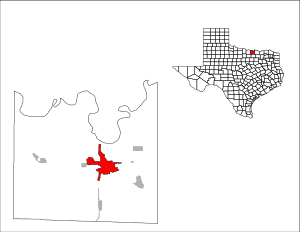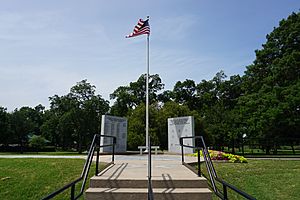Great Hanging at Gainesville facts for kids
Quick facts for kids Great Hanging at Gainesville |
|
|---|---|
| Location | Gainesville, Texas |
| Coordinates | 33°37′49″N 97°8′25″W / 33.63028°N 97.14028°W |
| Date | October 1862 |
| Victims | 41 |
The Great Hanging at Gainesville was a sad event that happened in Gainesville, Texas, in October 1862 during the American Civil War. Forty-one people who were thought to support the Union (the North) were executed. Two more people were shot while trying to escape.
About 150 to 200 men were captured by soldiers from the Confederate side (the South). Many people in North Texas did not like a new law that forced men to join the army, called "conscription" or the draft. Some of the captured men were put on trial by a group called the "Citizens' Court." This court was set up by a Confederate officer and made its own rules. It was not a real court under state law. Even though only a few families in the area owned slaves, most of the jury members were slave owners.
The accused men were executed one or two at a time. After some men were found guilty and executed, a large crowd became very angry. This crowd pressured the jury to give them 14 names, and these men were then killed without a trial. Later, 19 more men who had been found innocent were brought back to court and found guilty without any new proof. They were also executed because of the crowd's pressure. Most of the victims lived in Cooke County. This event is believed to be the largest mass execution in United States history. Eventually, the Confederate and state courts stopped the Citizens' Court.
Since 2007, people have held private events to remember the hangings. In 2012, the Cooke County Heritage Society planned a formal event for the 150th anniversary. However, the city's mayor objected, so the event was canceled. Still, a private family reunion brought together descendants of the victims to discuss what happened. In 2014, a memorial was built near where the executions took place to remember the event and its victims.
Contents
Understanding the Background
Cooke County's Early Days
Cooke County is in North Texas, close to the border with Oklahoma. It was set up in 1848. Its main town, Gainesville, was founded in 1850 and became the county seat in 1854. People started settling in North Texas in 1841. This was when William S. Peters and some investors made a deal with the Republic of Texas to bring settlers.
Settlement was slow and often involved groups of people taking the law into their own hands, known as "vigilantism." In 1858, the Butterfield Overland mail route came through Gainesville. This caused Cooke County's population to grow quickly, from 220 people in 1850 to 3,760 in 1860.
Texas and Slavery in 1860
In 1860, most Texans were not born in Texas. Many came from the Upper South. However, people from the Deep South who owned many slaves had a lot of power in Texas's government. Growing cotton made slave owners very rich. This connected Texas leaders to the future Confederacy.
Cooke County also saw a shift in power. Most people in Cooke County did not own slaves. By 1860, only about 11% of households in Cooke County owned slaves. But these slave owners included important county leaders like the chief justice and sheriff. Slave owners also controlled local volunteer armies. These groups often fought against nearby Native Americans. They also used violence against people they thought were helping Native Americans or were against slavery.
Growing Tensions and Disagreement
New people arriving on the Butterfield Overland route were sometimes thought to be against slavery. Some Methodist preachers who were against slavery were violently stopped by vigilantes. When several fires caused damage in North Texas, tensions grew very high. This led to violence where three slaves were executed in Dallas. A Methodist minister was killed, and many others were whipped. Many free Texans from the North were also killed or chased out of Texas.
Even though many Texans wanted to leave the Union, Cooke County often voted against it. Nearby U.S. Army forts helped protect Cooke County residents from Native American raids. People in Cooke County did not rely on slavery for their economy. They did not want to risk their safety to defend slavery. In the 1859 election for governor, 73% of Cooke County residents voted for Sam Houston. He was a Unionist who wanted Texas to stay in the Union.
However, events like John Brown's raid on Harpers Ferry and the election of Abraham Lincoln as president changed things. Support for leaving the Union grew in Texas. In North Texas, slave owners started holding rallies to support leaving the Union in late 1860. But not everyone in Cooke County agreed. In January 1861, the Texas Legislature voted to leave the Union. A vote was held in February, but it was affected by violence. Still, 61% of Cooke County voted to stay in the Union. This made it one of only 18 counties in Texas to vote against leaving.
Texas Joins the Confederacy
Texas left the Union on March 4, 1861. When Governor Sam Houston refused to support the Confederacy, he was removed from office. He was replaced by Lieutenant Governor Edward Clark. After Texas left the Union, hundreds of North Texans left the state to go to free areas. Confederate officials thought this meant all opposition to their side was gone.
But many people in North Texas were unhappy with the Confederacy. Refugees from other Confederate areas came to North Texas. Many of these were men trying to avoid the draft. This made people in North Texas feel more suspicious. Confederate rules also made people angry. The Sequestration Act of 1861 allowed the government to take and sell property from "enemy aliens." This was supposed to fund the government, but local officials kept most of the money in North Texas. War taxes and taking local guns and men were also disliked. But the most hated rule was conscription, or the draft, which became law on April 16, 1862.
In April, 30 men in Cooke County formed a "Union League." They signed a petition to the Confederate government. They complained that large slave owners were not being drafted into the army. A "Peace Party" was also active. Its members promised to resist the Confederate draft. Slave owners in the area worried that this group was working with Union forces from other states. They told local authorities about these groups.
After the Hangings
Official Reactions
Newspapers in Texas and Governor Francis Richard Lubbock praised the hangings. Pressure on people who disagreed with the Confederacy grew in Texas. The military was responsible for even more deaths. Newspapers in the North were shocked and angry when they heard about the events in Gainesville later.
Confederate President Jefferson Davis did not say anything about the hangings. He had already removed General Paul Octave Hébert as military commander of Texas on October 10. Hébert had put the state under military rule and was very strict about the draft. Confederate law did not have a punishment for men who did not report for the draft. President Davis felt Hébert did not control his local commanders well. He allowed military abuses to happen. Davis then appointed General John Bankhead Magruder to try and bring the state under control.
Continued Troubles in North Texas
Problems continued in North Texas for a while. Hundreds of families left the state to escape the violence. Military commanders sometimes helped angry mobs and sometimes tried to stop them. In Decatur, Captain John Hill oversaw the hanging of five men. A group of men was arrested in Sherman, Texas. But General James W. Throckmorton stepped in and saved all but five men who had already been killed by mobs.
In Sherman, E. Junius Foster, a newspaper editor, was murdered. He was killed by Captain Jim Young because Foster had publicly seemed happy about the death of Young's father. In Denton, another person who supported the Confederacy shot a prisoner dead.
Remembering the Event
Historical Marker and Controversy
In 1964, during the Civil War centennial, the Texas Historical Commission put up a historical marker. This marker supported the arrest and execution of the 42 men. It claimed the "Peace Party" had planned to destroy the government, kill leaders, and bring in Union soldiers. It also said the quick trials were needed because people feared the prisoners would be rescued. We now know this story was based on incomplete information because many records were lost.
Arguments about the event have continued into the 21st century. In 2012, Gainesville, a city of 16,000 people, was called "the most patriotic small town in America" by Rand McNally. That year, the Cooke County Heritage Society planned an event in October to mark the 150th anniversary of the Great Hanging. This was part of Civil War history. But the city's mayor objected to the marketing for the event, and it was canceled. The city gives money to the society's museum, and directors worried about losing support. The mayor wanted to focus on the city's new "patriotic" status and another annual event. Descendants of the victims were angry that the event would not be recognized. A member of the Cooke County Heritage Society said, "Gainesville has been hiding from the Great Hanging since it happened."
Commemoration and Memorial
Colleen Carri, a heritage society board member, decided to combine the commemoration with a Clark family reunion already planned for October 13. She expected 220 people, including descendants of six other victims. They called the event "Remembering Our Past, Embracing Our Future." Richard B. McCaslin, a history professor, was scheduled to speak. He wrote a book called Tainted Breeze: The Great Hanging at Gainesville, Texas 1862 (1994). This book is seen as the first full study of the event.
At the same time, members of the local chapter of Sons of Confederate Veterans made a video called Black October 1862. Some of them are descendants of the executed men. They said some victims were not innocent but were "traitors" for giving information to the enemy. Professor McCaslin says no proof of such activities was found. The Sons of Confederate Veterans planned to show their film on October 13, 2012.
Some people in Gainesville have led annual events to remember the hangings since 2007. A memorial for the victims was built privately in 2014. It has two large granite slabs. It was placed in a small park near where the hangings happened. One slab lists the names of the 42 victims. The other slab tells the full story of the events, based on documented history.



